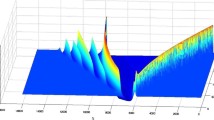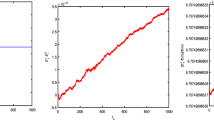Abstract
Du Fort-Frankel (DFF) finite difference method (FDM) was proposed for linear diffusion equations with periodic boundary conditions by Du Fort and Frankel in 1953. It is an explicit and unconditionally von Neumann stable scheme. Thus, it is very easy to be implemented and suitable for long-term simulations. However, there has been no research work on numerical solutions of sine-Gordon equations (SGE) and nonlinear coupled sine-Gordon equations (CSGEs) by using energy-preserving Du Fort-Frankel finite difference methods (EP-DFF-FDMs). In this study, two classes of weighted EP-DFF-FDMs, which are devised by combining DFF FDMs with invariant energy quadratization methods (IEQMs), are suggested for numerical simulations of SGE and CSGEs, respectively. By using the discrete energy method, it is shown that their solutions satisfy the discrete energy conservative laws, and converge to exact solutions with an order of \(\mathcal {O}(\tau ^{2}+{h^{2}_{x}}+{h^{2}_{y}}\) \(\displaystyle +(\frac {\tau }{h_{x}})^{2}+(\frac {\tau }{h_{y}})^{2})\) in H1-norm. Here, τ denotes time increment, while hx and hy represent spacing grids in x- and y-dimensions, respectively. What is more, our methods with parameter 𝜃 ≥ 1/4 are unconditionally stable in L2-norm though they are explicit schemes. Finally, numerical results confirm the exactness of theoretical findings, and the superiorities of our algorithms over some existent algorithms in terms of computational efficiency and the ability to conserve the discrete energy.





Similar content being viewed by others
Data Availability
We state that the datasets generated during and/or analyzed during the current study are available from the corresponding author on reasonable request.
References
Leibbrandt, G.: New exact solutions of the classical sine-Gordon equation in 2 + 1 and 3 + 1 dimensions. Phys. Rev. Lett. 41, 435–438 (1978)
Leibbrandt, G., Mort, R., Wang, S.S.: Solutions of the sine–Gordon equation in higher dimensions. J. Math. Phys. 21, 1613–1624 (1980)
Aero, E.L., Bulygin, A.N., Pavlov, Y.V.: Solutions of the three-dimensional sine-Gordon equation. Theor. Math. Phys. 158(3), 313–319 (2009)
Li, J.B.: Exact traveling wave solutions and dynamical behavior for the (n + 1)-dimensional multiple sine-Gordon equation. Science in China Series A: Mathematics 50(2), 153–164 (2007)
Johnson, S., Suarez, P., Biswa, A.: New exact solutions for the sine-Gordon equation in 2 + 1 dimensions. Comput. Math. Math. Phys. 52(1), 98–104 (2012)
Wazwaz, A.M.: The tanh method: Exact solutions of the sine-Gordon and the sinh-Gordon equations. Appl. Math. Comput. 167, 1196–1210 (2005)
Deng, D., Zhang, C.: A family of new fourth-order solvers for a nonlinear damped wave equation. Comput. Phys. Commun. 184, 86–101 (2013)
Strauss, Vazquez: Numerical solution of a nonlinear Klein-Gordon equation. J. Comput. Phys. 28, 271–278 (1978)
Guo, B., Pascual, P.J., et al: Numerical solution of the sine-Gordon equation. Appl. Math. Comput. 18, 1–14 (1986)
Li, S., Vu-Quoc, L.: Finite difference calculus structure of a class of algorithm for the nonlinear Klein-Gordon equation. SIAM J. Numer. Anal. 32, 1839–1875 (1995)
Zhang, F., Vazquez, L.: Two energy conserving numerical schemes for the sine-Gordon equation. Appl. Math. Comput. 45, 17–30 (1991)
Cai, W., Jiang, C., Wang, Y., Song, Y.: Structure-preserving algorithms for the two-dimensional sine-Gordon equation with Neumann boundary conditions. J. Comput. Phys. 395, 166–185 (2019)
Wang, Y., Wang, B., Ji, Z., Qin, M.: High order symplectic schemes for the sine-Gordon equation. J. Phys. Soc. Japan 72(11), 2731–2736 (2003)
Jiang, C., Cai, W., Wang, Y.: A linearly implicit and local energy-preserving scheme for the sine-Gordon equation based on the invariant energy quadratization approach. J. Sci. Comput. 80, 1629–1655 (2019)
Hou, B., Liang, D.: Energy-preserving time high-order AVF compact finite difference schemes for nonlinear wave equations with variable coefficients. J. Comput. Phys. 421, 109738 (2020)
Yan, J., Deng, D., Lu, F., Zhang, Z.: A new efficient energy-preserving finite volume element scheme for the improved Boussinesq equation. Appl Math Model 87, 20–41 (2020)
He, M., Sun, P.: Energy-preserving finite element methods for a class of nonlinear wave equations. Appl. Numer. Math. 157, 446–469 (2020)
Jiang, C., Sun, J., Li, H., Wang, Y.: A fourth-order AVF method for the numerical integration of sine-Gordon equation. Appl. Math. Comput. 313(15), 144–158 (2017)
Khusnutdinova, K.R., Pelinovsky, D.E.: On the exchange of energy in coupled Klein–Gordon equations. Wave Motion 38, 1–10 (2003)
Kontorova, T.A., Frenkel, Y.I.: On the theory of plastic deformation and twinning I, II. Zhurnal Eksperimental’noii Teoreticheskoi Fiziki 8(89–95), 1340–1368 (1938)
Braun, O.M., Kivshar, Y.S.: Nonlinear dynamics of the Frenkel–Kontorova model. Phys. Rep. 306, 1–108 (1998)
Yomosa, S.: Soliton excitations in deoxyribonucleic acid (DNA) double helices. Phys. Rev. A 27, 2120–2125 (1983)
Salas, A.H.: Exact solutions of coupled sine-Gordon equations. Nonlinear Anal.: RWA 11, 3930–3935 (2010)
Hosseini, K., Mayeli, P., Kumar, D.: New exact solutions of the coupled sine-Gordon equations in nonlinear optics using the modified Kudryashov method. J. Morden Optics 65, 361–364 (2018)
Ekici, M., Zhou, Q., Sonmezoglua, A., Mirzazadehc, M.: Exact solitons of the coupled sine-Gordon equation in nonlinear system. Optik 136, 435–444 (2017)
Ilati, M., Dehghan, M.: The use of radial basis functions (RBFs) collocation and RBF-QR methods for solving the coupled nonlinear sine-Gordon equations. Eng. Anal. Bound. Elem. 52, 99–109 (2015)
Kumar, K.H., Vijesh, V.A.: Chebyshev wavelet quasilinearization scheme for coupled nonlinear sine-Gordon equations. J. Comput. Nonlinear Dynam. 12, 011018 (2017)
Deng, D., Liang, D.: The time fourth-order compact ADI methods for solving two-dimensional nonlinear wave equations. Appl. Math. Comput. 329, 188–209 (2018)
Deng, D., Liang, D.: The energy preserving finite difference methods and their analyses for system of nonlinear wave equations in two dimensions. Appl. Numer. Math. 151, 172–198 (2020)
Deng, D., Wu, Q.: The studies of the linearly modified energy-preserving finite difference methods applied to solve two-dimensional nonlinear coupled wave equations. Numer. Algor. 88, 1875–1914 (2021)
Macías-Díaz, J.E.: A structure-preserving method for a class of nonlinear dissipative wave equations with Riesz space-fractional derivatives. J. Comput. Phys. 351, 40–53 (2017)
Xie, J., Zang, Z: An effective dissipation-preserving fourth-order difference solver for fractional-in-space nonlinear wave equations. J. Sci. Comput. 89, 1753–1776 (2019)
Yang, X., Zhao, J., Wang, Q.: Numerical approximations for the molecular beam epitaxial growth model based on the invariant energy quadratization method. J. Comput. Phys. 333, 104–127 (2017)
Yang, X., Zhao, J., Wang, Q., Shen, J.: Numerical approximations for a three components Cahn-Hilliard phase-field model based on the invariant energy quadratization method. Math Models Methods Appl Sci 27, 1993–2030 (2017)
Zhao, J., Yang, X., Gong, Y., Wang, Q.: A novel linear second order unconditionally energy stable scheme for a hydrodynamic-tensor model of liquid crystals. Comput. Methods Appl. Mech. Engrg. 318, 803–825 (2017)
Yang, X., Zhao, J., He, X.: Linear second order and unconditionally energy stable schemes for the viscous Cahn–Hilliard equation with hyperbolic relaxation using the invariant energy quadratization method. J. Comput. Appl. Math. 343, 80–97 (2018)
Yang, X., Zhang, G.: Convergence analysis for the invariant energy quadratization (IEQ) schemes for solving the Cahn-Hilliard and Allen-Cahn equations with general nonlinear potential. J. Sci. Comput. 82, 55 (2020)
Liu, Z., Li, X.: Efficient modified stabilized invariant energy quadratization approaches for phase-field crystal equation. Numer. Algor. 85, 107–132 (2020)
DuFort, E.C., Frankel, S.P.: Conditions in the numerical treatment of parabolic differential equations. Math. Tables Other Aids Comput. 7(43), 135–152 (1953)
Corem, N., Ditkowski, A.: New analysis of the Du Fort–Frankel methods. J. Sci. Comput. 53, 35–54 (2012)
Dai, W.: An unconditionally stable three-level explicit difference scheme for Schrödinger equation with a variable coefficient. SIAM J. Numer. Anal. 29(1), 174–181 (1992)
Wu, L.: Du Fort-Frankel-type methods for linear and nonlinear Schrödinger equations. SIAM J. Numer. Anal. 33, 1526–1533 (1996)
Ivanauskas, F., Radziunas, M.: On convergence and stability of the explicit difference method for solution of nonlinear Schrödinger equations. SIAM J. Numer. Anal. 36(5), 1466–1481 (1999)
Markowich, P.A., Pietra, P., Pohl, C., Stimming, H.P.: A wigner-measure analysis of the Dufort-Frankel scheme for the Schrödinger equation. SIAM J. Numer. Anal. 40(4), 1281–1310 (2002)
Liao, H., Zhang, Y., Zhao, Y., Shi, H.: Stability and convergence of modified Du Fort–Frankel schemes for solving time-fractional subdiffusion equations. J. Sci. Comput. 61, 629–648 (2014)
Al-Shibani, F., Ismail, A.: Compact Crank–Nicolson and Du Fort–Frankel method for the solution of the time fractional diffusion equation. Int. J. Comput. Meth. 12(6), 1550041 (2015)
Radwan, S.F.: Comparison of higher-order accurate schemes for solving the two-dimensional unsteady Burgers’ equation. J. Comput. Appl. Math. 174, 383–397 (2005)
Masoudi, H.M., Arnold, J.M.: Parallel efficient three-dimensional beam propagation method using the Du Fort-Frankel technique. Microw. Opt. Technol. Lett. 24(3), 179–182 (2005)
Acknowledgements
The authors are very grateful to the referees for their valuable comments and suggestions, which have helped to improve the paper. We are also very grateful to Editor in Chief Claude Brezinski for his kind help.
Funding
This work is partly supported by the National Natural Science Foundation of China (Nos. 11861047), Natural Science Foundation of Jiangxi Province for Distinguished Young Scientists (No. 20212ACB211006), and Natural Science Foundation of Jiangxi province (No. 20202BABL201005).
Author information
Authors and Affiliations
Corresponding author
Ethics declarations
Conflict of interest
The authors declare no competing interests.
Additional information
Publisher’s note
Springer Nature remains neutral with regard to jurisdictional claims in published maps and institutional affiliations.
Rights and permissions
Springer Nature or its licensor (e.g. a society or other partner) holds exclusive rights to this article under a publishing agreement with the author(s) or other rightsholder(s); author self-archiving of the accepted manuscript version of this article is solely governed by the terms of such publishing agreement and applicable law.
About this article
Cite this article
Deng, D., Chen, J. & Wang, Q. Energy-preserving Du Fort-Frankel difference schemes for solving sine-Gordon equation and coupled sine-Gordon equations. Numer Algor 93, 1045–1081 (2023). https://doi.org/10.1007/s11075-022-01453-1
Received:
Accepted:
Published:
Issue Date:
DOI: https://doi.org/10.1007/s11075-022-01453-1




